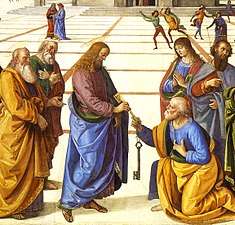Devil's advocate
| Part of a series on the |
| Hierarchy of the Catholic Church |
|---|
 |
| Ecclesiastical titles (order of precedence) |
|
|
Liturgical titles |
|
Administrative and pastoral titles
|
|
Consecrated and professed titles |
|
Additional titles |
|
Organization titles |
|
 |
| Part of a series on the |
| Jurisprudence of Catholic canon law |
|---|
|
Trials and tribunals |
|
Canonical structures Particular churches
|
|
|
Procedural law Election of the Roman Pontiff
|
|
Academic degrees |
|
|
The Advocatus Diaboli (Latin for Devil's Advocate) was an official position within the Catholic Church: one who "argued against the canonization (sainthood) of a candidate in order to uncover any character flaws or misrepresentation of the evidence favoring canonization".[1]
In common parlance, the term devil's advocate describes someone who, given a certain point of view, takes a position he or she does not necessarily agree with (or simply an alternative position from the accepted norm), for the sake of debate or to explore the thought further. Despite being ancient, this idiomatic expression is one of the most popular present-day English idioms used to express the concept of arguing against something without actually being committed to the contrary view.[2]
Origin and history
During the canonization process employed by the Roman Catholic Church, the Promoter of the Faith (Latin: promotor fidei), popularly known as the Devil's advocate (Latin: advocatus diaboli), was a canon lawyer appointed by Church authorities to argue against the canonization of a candidate.[3] It was this person’s job to take a skeptical view of the candidate's character, to look for holes in the evidence, to argue that any miracles attributed to the candidate were fraudulent, and so on. The Devil's advocate opposed God's advocate (Latin: advocatus Dei; also known as the Promoter of the Cause), whose task was to make the argument in favor of canonization. During the investigation of a cause, this task is now performed by the Promoter of Justice (promotor iustitiae), who is in charge of examining the accuracy of the inquiry on the saintliness of the candidate.[4] The Promoter of the Faith remains a figure in the Congregation of the Causes of Saints and is also known as the Prelate Theologian.[5]
The office was established in 1587 during the reign of Pope Sixtus V. The first formal mention of such an officer is found in the canonization of St. Lawrence Justinian under Pope Leo X (1513-1521).[6] Pope John Paul II reduced the power and changed the role of the office in 1983. In cases of controversy the Vatican may still seek to informally solicit the testimony of critics of a candidate for canonization. The number of canonisation increased, from 330 between 1588 and 1978, to 483 under John Paul II's pontificate (1978-2005, that is an average of 18 canonisations per year).
See also
- Concern troll – a false flag pseudonym created by a user whose actual point of view is opposed to the one that the troll claims to hold
- Dialectic
- Dissoi logoi
- Lawsuits against the Devil
- Murder board
- Polemic
- Red team
- Roman Rota
- Social gadfly – person who upsets the status quo by posing upsetting or novel questions
References
- ↑ Helterbran, Valeri R. (1 January 2008). Exploring Idioms. Maupin House Publishing, Inc. p. 40. ISBN 9781934338148.
Devil's Advocate Definition: To take an opposing position for the sake of argument. Background: Devil's advocate is taken from a role formerly used in the canonization process in the Roman Catholic Church. In 1587, Pope Sixtus V established a process involving a canon attorney in the role of Promoter of the Faith or Devil's Advocate. This person argued against the canonization (sainthood) of a candidate in order to uncover any character flaws or misrepresentation of the evidence favoring canonization.
- ↑ Devil's advocate meaning. The Idioms
- ↑ Fanning, W. (1911). "Promotor Fidei". Catholic Encyclopedia. 12. New York: Robert Appleton Company. OCLC 811253232. Retrieved 2018-01-19.
- ↑ Gray, Jason A. The Evolution of the Promoter of the Faith in Causes of Beatification and Canonization of Saints: A study of the law of 1917 and 1983 (PDF). jgray.org (PhD). Retrieved 2018-01-19.
- ↑ John Paul II (1983-01-25). "Divinus Prefectionis Magister". Vatican City: Libreria Editrice Vaticana. Retrieved 2018-01-19.
- ↑ Burtsell, Richard (1907). "Advocatus Diaboli". The Catholic Encyclopedia. 1. New York: Robert Appleton Company. OCLC 875120339. Retrieved 2018-01-19.
External links
| Look up devil's advocate in Wiktionary, the free dictionary. |


- The evolution of the Promoter of the Faith in causes of canonization